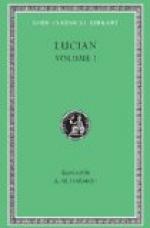In the year 1831, a negro named Turner, supported by six desperate and misguided fellow countrymen, started out on what they regarded as a practical crusade against slavery. Turner professed to have seen visions such as inspired Joan of Arc, and he proceeded to fulfill what he regarded as his divine mission, in a very fanatical manner. First, the white man who owned Turner was murdered, and then the band proceeded to kill off all white men in sight or within convenient reach. Within two days nearly fifty white men were destroyed by those avenging angels, as they were called, and then the insurrection or crusade was terminated by the organizing of a handful of white men who did not propose to be sacrificed as had been their fellows.
Turner’s bravery was great when there was no resistance, but he recognized that discretion was the better part of valor the moment organized resistance was offered. Taking to the woods, he left his followers to shift for themselves. For more than a week he lived on what he could find in the wheat fields, and then, coming in contact with an armed white man, he speedily surrendered. A week later he was hanged, and seventeen other colored men suffered a like penalty for connection with the conspiracy. The murderous outbreak had other dire results for the negro, and caused many innocent men to be suspected and punished.
A year later, Garrison started the New England Anti-Slavery Society, which was followed by many similar organizations. So intense did the feeling become that President Jackson thought it advisable to recommend legislation excluding Abolition literature from the mails. The measure was finally defeated, but in the Southern States, particularly, a great deal of mail was searched and even condemned. Rewards were offered in some of the slave-holding States for the apprehension of some of the leading Abolitionists, and feeling ran very high, every outbreak being laid at the doors of the men who were preaching the new gospel of equal rights, regardless of color.
Mobs frequently took a hand in the proceedings, and several men were attacked and arrested on very flimsy pretexts. In 1836, the Pennsylvania Hall, in Philadelphia, was burned, because it had been dedicated by an anti-slavery meeting. So bitter did the feeling become that every attempt to open schools for colored children was followed by disturbance, the teachers being driven away and the books destroyed. Numerous petitions on the subject were sent to Congress, and there was an uproar in the House when it was proposed to refer a petition for the abolition of slavery in the District of Columbia to a committee. The Southern Congressmen withdrew from the House as a formal protest, and the word “secession,” which was subsequently to acquire such a much more significant meaning, was first applied to this action on their part.




